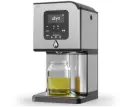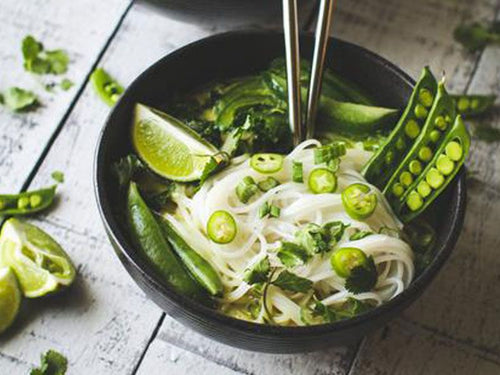Meet the oil built for heat, health, and creativity. Algae cooking oil is extracted from microalgae and designed for culinary enthusiasts who love experimenting in the kitchen. With a high smoke point, a neutral flavor, and a sustainable story, this oil works as hard as you do!
And yes, you can infuse it too.
A New Kind of Cooking Oil
Algae oil for cooking starts its journey as microalgae — a tiny, single-cell organism grown by farmers in tightly controlled, high-efficiency systems. Unlike macroalgae, such as seaweed and kelp, microalgae can pack serious oil content in a short time. Here’s how it happens:
Microalgae Cultivation & Growth
Fresh batches of micro-algae are grown in tanks or bioreactors, fed nutrients, sugar, and light until they’re full of oil-rich cells.
Harvesting & Drying Microalgae
In just a few days, the algae are collected, the water is removed, and they are dried, so the concentrated cells are ready for extraction.
Algae Oil Extraction
Much like olive oil, biomass is squeezed or mechanically processed to release its oil. The result is a clean, versatile algae cooking oil built for high-heat cooking and infusion.
High Heat? No Problem.
When it comes to searing, sautéing, roasting, and even serious stir-frying, temperature matters. That’s why the smoke point of oil is a big deal: it’s the temperature where the oil starts to break down, smoke, and lose both flavor and integrity.
When it comes to searing, sautéing, roasting, and even serious stir-frying, temperature matters. The smoke point of oil is a big deal because it’s the temperature at which the oil starts to break down, smoke, and lose both flavor and integrity.
Smoke point is also the point at which toxic compounds are formed. When unsaturated fatty acids in cooking oils are heated to high temperatures during frying, there is an increased risk of chronic diseases, such as cancer and cardiovascular disease, as well as more immediate effects like inflammation and irritation.
The great news? Algae oil is built for heat. Many retail sources list its smoke point at 535 °F (279 °C), while a study published in the National Institute of Health's National Public Database lists it as 485 °F (252 °C).1
How Culinary Algae Oil Stacks Up
If your cooking style demands high heat, intense flavor, or you plan on exploring infusions that go from machine to pan, algae oil is your high-performance base.
Oil |
Approx Smoke Point |
|
Algae Oil |
485-535 °F |
|
Refined Avocado Oil |
|
|
Extra Virgin Olive Oil |
|
|
Coconut Oil (unrefined) |
Taste & Flavor
When you hear “algae oil,” you might imagine it tasting like seaweed. In reality, most people say it has a mild, lightly buttery taste or even no taste at all.
Because the flavor is so clean, algae oil doesn’t steal the show, your ingredients do. Whether you’re infusing garlic, roasting veggies, or using bold spices, algae oil lets those flavors shine.
Health Benefits
The oil you cook with should do more than just taste good — it should support your wellness too. Here’s how algae cooking oil does that:
- Heart-Friendly Fats: Higher in monounsaturated fats (omega-9) and lower in saturated fats compared with many traditional oils.
- Balanced Fat Profile: Contains fewer omega-6 fats (which in excess may influence inflammation) and more of the fats that help your body perform.
- High Heat Stability: Because the oil remains stable at high heat, there’s less risk of breakdown into harmful compounds (which can happen when oils smoke or overheat).
Sustainability: Better for the Planet
When you use algae cooking oil, you’re not just choosing flavor and performance—you’re choosing smarter production. Here’s how this oil steps up:
Micro-algae can be grown in controlled tanks (not large crop fields), so they use far less land and don’t compete with farmland.
Production uses less water and emits fewer greenhouse gases compared to many traditional oils, such as olive or canola.
The controlled-growth process means you’re not reliant on seasons or vulnerable crops—so production is more stable and less impacted by climate stress.
As more chefs and infusion enthusiasts explore alternatives, microalgae oil is emerging as a category-definer rather than just a niche. At LĒVO, we’re proud to step into that space with intention.
How to Use Algae Oil in Your Kitchen
Algae cooking oil has a neutral flavour and high heat tolerance, making it incredibly versatile.
Use it for flash-charred veggies, stir-fries, or shellfish. It handles the heat without becoming bitter.
Swap it into baked goods like brownies, muffins, and cakes.
Use it in condiments and sauces like guacamole where you want to enhance creaminess or need a light texture with no “oil” aftertaste.
Algae Oil Infusion Ideas
- Chili + garlic infused algae oil: Infuse the oil with dried chilies and crushed garlic, then use it on pizzas, stir-fries, or roasted veggies for a spicy kick.
- Herb-infused algae oil: Infuse with rosemary, thyme, or basil for marinades, dressings, or drizzling over grilled meats/vegetables.
- Mushroom infused algae oil: infuse with your favorite, antioxidant-rich mushrooms like lion’s mane or shiitake - or use infuse with a mushroom melange for hearty umami flavors.
The flavor of algae cooking oil is so clean, it lets your ingredients do the heavy lifting when delivering flavor. Want your garlic, rosemary, or chili to shine? This oil is the stage for your ingredients to be the star.
Ready to Level Up Your Kitchen?
Explore our algae cooking oil and elevate your kitchen setup with an oil built for flavor, performance, and purpose.
—----------------------
1. Moumtaz, S., Percival, B. C., Parmar, D., Grootveld, K. L., Jansson, P., & Grootveld, M. (2019). Toxic aldehyde generation in and food uptake from culinary oils during frying practices: Peroxidative resistance of a monounsaturate-rich algae oil. Scientific Reports, 9, 4125. https://doi.org/10.1038/s41598-019-39767-1

























Leave a comment
All comments are moderated before being published.
This site is protected by hCaptcha and the hCaptcha Privacy Policy and Terms of Service apply.